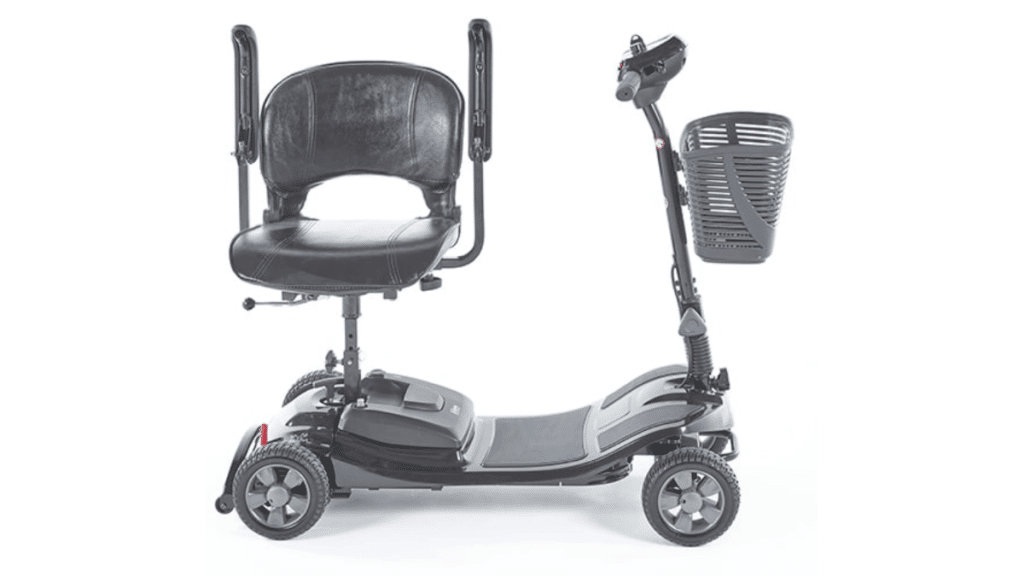When looking at the practicalities of your new mobility scooter there are a number of things to consider, especially in terms of how best to operate them. Reviewing the different types of mobility scooters and how best to drive them can help guide you on this journey.
Different mobility scooter types
There are Class 2 and Class 3 scooters. Class 2 scooters, which can often be folded and stored in a car boot, are smaller and slower than their larger and faster Class 3 cousins. Bigger batteries in Class 3 scooters give them extended range over Class 2 models. Class 2 scooters are intended for pavement use while Class 3 scooters are for the road or pavement.
Where to drive
Driving on the pavement is naturally safer than driving on the road. Class 2 and 3 scooters are suitable options for pavements. However, it is always important to be aware of pedestrians – especially those with pushchairs and young children, and those with disabilities – when driving on the pavement.
Driving on the road is the preserve of Class 3 scooters. This can be a safe option, but it is essential to steer clear of motorways and bus or cycle lanes. Also, over 50 mph dual carriageways must be avoided. The Highway Code covers specific legal requirements.
Speed limits
Class 2 scooters have a maximum speed of 4 mph (6 km/h), which is faster than the average walking speed of 3 mph. Class 3 scooters can reach speeds of 8 mph (12 km/h) and any speed over 4 mph must legally only be used on the road.
Weights and load limits
Class 3 scooters can weigh upwards of 23 stone. Much lighter Class 2 scooters carry maximum weights of 17 ½ stone, although it is not uncommon for them to weigh as little as 3 stone.
Equally as important is the load that scooters can bear. Consider the amount of baggage, shopping or medical equipment being carried on the scooter and avoid unbalancing it with bags on the handlebars. Scooters often have small baskets at the front that can be used for storage and there are often accessory options available too for convenience such as canopies, cup holders and bag covers.
Parking
Avoid leaving a scooter unattended if it is blocking pedestrians or wheelchair users. Otherwise, all normal parking restrictions apply to scooter users and the Highway Code is a good reference point.
Road ready
Class 3 scooters must legally have lights, a horn, working brakes, indicators and a rear-view mirror. Lights must be used when it is dark and wearing reflective clothing or adding reflective strips to the back of the vehicle enhances safety.
Leasing
Leasing a scooter through the Motability Scheme covers the following:
- Insurance: Report any accident incident to Direct Line Motability (DLM) via the ‘Insurance’ section of the Motability Scheme online account.
- Breakdown: For any scooter breakdowns, get to a safe place and then call Motability Assist on 0800 953 5000, who will take you and your product home. Your dealer will follow up on any scooter repair needs.
- Tyres: Tyres damaged through normal use (subject to the fair usage policy) can be replaced. This includes puncture repair for air-filled tyres.
- Batteries: Contact your dealer with any battery issues, who can arrange a replacement. They typically last between 1-3 years.
Eyesight
Good eyesight is necessary for judging distances, recognising danger and protecting yourself and others when driving a scooter. Although not a legal requirement, it is recommended to have an eyesight test every 2 years and use driving glasses if you have them.
Mobility scooter requirements
Mobility scooters are for those who have trouble walking, either from an injury, physical disability or medical condition. Under 14-year-olds are limited to using Class 2 scooters only, Class 3 scooters must be registered with the DVLA, road tax is not required and nor is a driving license in any circumstance.
